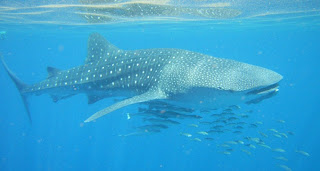Turquoise Bay
On our first full day in Exmouth, we headed out to Turquoise Bay for some more snorkelling. when we stopped at the information centre Neil noticed this goanna walking through the carpark.
Turquoise Bay was another great place for snorkelling. Right near the edge you can swim with schools of quite large white fish - different varieties. The super thing about Turquoise Bay is that you walk up the beach and get in and one end (looking at all of the beautiful fish) and the current carries you along the reef to the other end of the beach. You do have to be careful to get out before you pass the sand bank or you could get carried out to sea!!! Our snorkels, goggles and flippers have had a good workout! Sorry, no photos; we were too busy having a lovely time in the water!
A short drive back to Exmouth from Turquoise Bay is the Jurabi Turtle Centre. We were expecting some kind of museum, information centre - and in a way it was...
There was a sheltered area with some information about turtles and turtle breeding, including a taxonomied turtle in a glass case and in another glass case some of the turtles predators. From there there was a short walk to one of the beaches which the sea turtles frequent to lay their eggs. Unfortunately we had just missed the season for this. There were crabs everywhere on this beach - food for big turtles and predators for baby turtles!
 |
| A cute crab waiting to eat or be eaten by a turtle - maybe both! |
Maddi and Libby had been planning to swim with whalesharks ever since the plan to visit Ningaloo reef was made, so we handed over all of our money and headed off (@7.15am - I thought this was supposed to be a holiday) for the day.
 |
| If you look carefully in the middle of this picture you will see the top of a whale shark - enlarge it! Look for darker blue and some white spots. |
 |
| This one too... |
Apparently in Australian waters we really only see young males who haven't yet reached maturity or full size. (They are still quite big for sharks!) Luckily they are filter feeders (not human eaters) and are only there for the coral spawning - apparently quite tasty food for teenage male whalesharks . The water is cloudy with plankton and coral spawn which means the vision is not as clear as when snorkelling on the beach side of the reef.
 |
| This is another whaleshark tour boat as seen from our boat. you can see all of the people standing at the end of the boat preparing to jump into the water. |
We were lucky enought to see 6 whalesharks on our trip. They were all quite close together which was apparently unusual as whalesharks are supposedly solitary animals. Not much is known about them, especially about where the females are, how they mate, where they go when they are not at the known sites etc. We were lucky enough to have a whaleshark researcher from the US on the boat with us. He was hoping to collect some tags from whalesharks but none that we saw actually had tags.
Swimming with whale sharks is pretty cool, but it is very expensive and due to regulations (and demand to do the tours) is quite rushed. Money from each dive goes to protecting whalesharks which justifies at least some of the cost. Only 10 divers plus two guides are allowed in the water with a whaleshark at any one time, which means they book 20 people onto a tour and you have to keep jumping in and out to give the other group a turn.
It goes a bit like this. You have to be ready to go at any time. Your group goes to the end of the boat. The boat stops in front of the whale shark. Your guide jumps in and swims towards the whaleshark to ensure it is located properly. Their hand goes up and the group has to rush into the water, look for the approaching whaleshark, choose a side to move to and then allow the shark to swim past. Then there is usually quite a bit of fast swimming required to swim alongside the shark for a while before it either goes past you or dives. The other group is dropped in front of the whale shark before the boat comes back around to pick you up. You are told to hurry to get out of the water and you have to use your own body strength - there is no ladder - no time! Then you sit for a second or two before you have to jump in again. I am exhausted writing about it. Maddi loved it - loves a challenge - and she seems to be able to swim for ages as fast as a whaleshark so she didn't find it stressful at all!
We were very lucky that the last whaleshark we swam with decided not to swim away but to circle around and around checking out the weird looking creatures in the waters of Ningaloo Reef. This meant we weren't too exhausted after our last swim - just a bit dizzy!



This is indeed a swag. I love seeing sea creatures. Want to try that adventures,you are always welcome to visit in this site.
ReplyDeleteGreat article with excellent idea! I appreciate your post. Thanks so much and let keep on sharing your stuffs keep it up.
ReplyDeleteNingaloo Reef Fishing